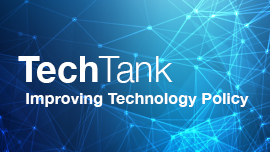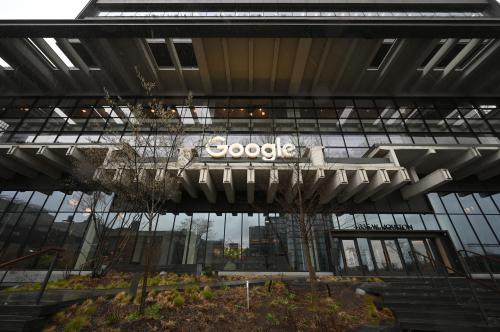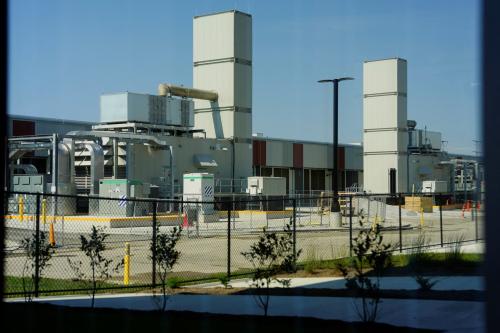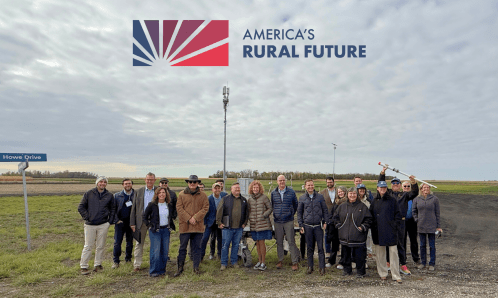Sarah Friar, chief financial officer of OpenAI, recently floated the idea of government support for the vast amounts of capital necessary to build the United States’ AI computing infrastructure. Her original suggestion of a government guarantee “that allows the financing to happen,” was quickly attacked online and subsequently clarified to, “American strength in technology will come from building real industrial capacity which requires the private sector and government playing their part.”
It’s not a new idea. The transcontinental railroad of the 19th century was also made possible by the support of the United States government in the form of land grants and long-term loans to private railroad companies. The lessons of that experience should inform any similar 21st century effort—that public support for private entities must be accompanied by public interest expectations.
Railroads were the physical infrastructure that enabled the industrial economy; computing power has become the infrastructure of the intelligence economy. Railroads used their public subsidies to build private empires that controlled markets and enriched their investors. If the new privately owned AI infrastructure is to be publicly financed, such support must be accompanied by public interest obligations that it is available on nondiscriminatory, open, and fair terms. The lesson of the railroad era is simple: Private infrastructure underwritten by public funds must be open for the public benefit.
Lessons from the railroad precedent
The Pacific Railway Act of 1862 and its amendments granted private railroad companies ownership of alternating one-mile sections of public land in a checkerboard pattern along the path of their track. As the companies sold those lands to settlers and speculators, the value of the subsidy, calculated at pre-rail prices, grew because of the arrival of rail service, allowing the railroads to profit from the very activity being subsidized.
The federal government also issued low-interest 30-year loans to the railroads. The railroads then double-dipped by issuing their own private bonds secured by the same assets. It was a highly leveraged public-private partnership where the federal government socialized the risks while the railroads privatized the rewards.
Presumably in recognition of the local monopolies it was creating, the federal government conditioned its subsidy on receiving special low rates and other beneficial terms for government freight and passengers. The citizens of single-line small towns that relied on the railroad had no such leverage, however. The farmers and settlers who had bought land from the railroad company were subjected to what economists call “monopoly rents”—rates as high as the market would bear. As I wrote in “From Gutenberg to Google: The History of Our Future,” a short haul from the farmers’ small town to an entrepôt such as Minneapolis or Chicago might cost as much as twice per unit of weight as would a longer haul across a route with competitive carriers.
After decades of exploitative behavior by the railroads, public anger led Congress in 1887 to create the first federal regulatory agency, the Interstate Commerce Commission (ICC). Reflecting how the railroads exercised their market power to discriminate among shippers, localities, or types of traffic, the ICC’s mandate was to prohibit “undue or unreasonable preference or advantage.” The significance of this today is how the government was forced to deal with the problems created by it subsidizing corporate activity without establishing behavioral expectations.
Enter AI—the ‘railroads’ of the digital age
Today’s AI infrastructure—advanced semiconductors, massive data centers, and cloud computing platforms—is the 21st century counterpart to 19th century railroads. Both are capital-intensive, networked infrastructure whose value lies not only in the assets themselves but also in what others can build upon them.
We have entered what tech analyst Azeem Azhar calls the “infinite-compute economy”—a world of seemingly boundless computational capacity required for AI. This represents, in his words, “a structural re-engineering of the economy” from one that “uses computation to one that is built on computation.” Just as the industrial economy was built on the railroad, the AI economy is being constructed atop computing power.
The 19th century railroad was a physical troika of tracks, engines, and depots. The AI economy is a similar triad of semiconductors generating computational power, data centers where such compute is performed, and cloud platforms that organize and distribute the compute.
This new infrastructure is massively expensive. According to a 2025 McKinsey & Company report, global capital expenditures on AI data centers will reach a cumulative $5.2 trillion by 2030. McKinsey estimates 40% of those expenditures (approximately $2 trillion) will be in the United States.
Manipulating markets by controlling resources
The industrial era, powered by railroads, was built on what economists call “rivalrous” assets—hard assets such as coal and steel whose use denied usage by others. A classic example of a rivalrous asset is how the use of a ton of coal eliminates its use by anyone else.
The digital era, in contrast, is built on soft “non-rivalrous” assets such as data, algorithms, and computing capacity—assets that can be shared or replicated without depletion. A data file or algorithm, for instance, can be used repeatedly without diminishing its functional value or capabilities.
Railroad executives—and Big Tech executives a century later—learned to manufacture scarcity from abundance through anticompetitive alchemy. Prior to the ICC, railroad executives’ discriminatory policies limited access to their tracks, thus making rivalrous what otherwise would have been open and non-rivalrous. Today’s dominant digital companies employ similar tactics to create scarcity by controlling non-rivalrous digital resources through proprietary access and pricing power.
Nineteenth century government subsidies allowed railroad companies to turn public resources into private monopolies. Ultimately, the harmful folly of such practices was recognized, and the closed discriminatory practices of the rail system were opened through regulation. It is a lesson that should inform any federal role in AI infrastructure.
Public risk requires public reward
If public guarantees or subsidies are to finance capital costs of the intelligence economy, they must finance access, not empires. Such policies could catalyze domestic AI-based innovation and geopolitical competitiveness—but only if they expand opportunity through open infrastructure available on just and reasonable terms.
The three essential components of the digital economy are data, computing power, and digital distribution. We have already seen how, absent oversight, Big Tech companies have manipulated these resources to dominate markets. As Big Tech expands to become Big AI, the need for open, nondiscriminatory access to these essential inputs only increases.
Data is the raw material of the digital economy. The more data AI models have to digest, the more powerful they become. Public policy should create expectations of interoperability and portability to ensure the raw material is openly available to those seeking to innovate.
Computing power is the locomotive engine of AI. Just as Congress required of railroads in 1887, it must be free of “unjust discrimination” and “unjust or unreasonable preference or advantage.” The hundreds of billions of dollars being invested in data centers and semiconductors must not become a barrier to entry for competition-driving innovation.
Finally, the transformational effect of AI will come from its diffusion. As such, there must be open distribution channels, including open links to foundation models, in lieu of the kind of self-preferencing digital companies have practiced thus far.
The history of the 19th century has taught us how nondiscriminatory access to essential infrastructure is not regulatory overreach, but rather a precondition of competition. It is a lesson we cannot forget as AI executives and policymakers pursue the expansion of the AI economy.
The Brookings Institution is committed to quality, independence, and impact.
We are supported by a diverse array of funders. In line with our values and policies, each Brookings publication represents the sole views of its author(s).








Commentary
OpenAI floats federal support for AI infrastructure—what should the public expect?
November 18, 2025